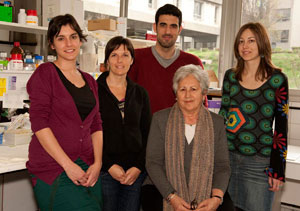New advances in drugs for Alzheimer's disease

04/06/2012
In the development of this new molecule, researchers used the strategy of “multipotent drugs”, capable of acting simultaneously on different targets in the brain involved in this neurodegenerative disease, given that the paradigm used in the design of drugs based on the strategy of “one drug, one target” has shown to be unsuitable in offering satisfactory results.
ASS234 was developed as a hybrid of two known molecules. One of them, donepezil, is currently used to treat Alzheimer's disease, and the other, PF9601N compound, is an inhibitor of the monoamino oxidase B (MAO B) enzyme, patented and developed by researchers at UAB and CSIC, with proven neuroprotective effects in different experimental models of Parkinson's disease.
The research was directed by Mercedes Unzeta, researcher of the Department of Biochemistry and Molecular Biology and of the Institute of Neurosciences (INc) at UAB, José Luis Marco Contelles, CSIC researcher at the Institute of General Organic Chemistry (IQOG), and F. Javier Luque, researcher of the Department of Physico-Chemistry at the Faculty of Pharmacy and the Institute of Biomedicine of the UB (IBUB).
All three researchers have worked for years on the design, synthesis and biological evaluation of new multipotent molecules capable of stimulating neural transmissions and at the same time having neuroprotective effects. ASS234 acts on both of these processes.
The biochemical activity and pharmacological potential of the molecule was exhaustively characterised by Irene Bolea (UAB) and synthesised by Abdelouahid Samadi (CSIC). Previous studies on the interactions of ASS234 with its possible targets were carried out by Jordi Juárez-Jiménez (UB). The ASS234 molecule has been patented by all three institutions.
This molecule could be much more efficient than other compounds used to stimulate neural transmission and simultaneously act on different brain targets. To date, in vitro investigations conducted at UAB have demonstrated that ASS234, in addition to being able to inhibit monoamino oxidases A and B, also act on the enzymes acetylcholinesterase and butyrylcholinesterase, thus helping to boost levels of acetylcholine, a neurotransmitter deficient in patients with Alzheimer's. The latest results obtained indicate that ASS234 also reduces aggregation of the β-amyloidprotein which gives way to the appearance of senile plaques characteristic of the disease.
Other recent studies conducted by researchers of the CSIC Cajal Institute and the University of Lodz, Poland, have demonstrated that ASS234 is able to cross the blood-brain barrier and improves memory in mice.
All studies conducted to date make clear that ASS234 is a promising multitarget molecule due to its potential therapeutic effects on patients with Alzheimer's disease.
As affirmed by Dr Unzeta and Dr Marco Contelles, ASS234 “a priori appears as a derivative of donepezil, which contains not only its virtues but possesses also a potential multipotent profile, which could make it a more efficient drug for the treatment of this disease”.
The research on ASS234 and results obtained was recently published in the Journal of Medicinal Chemistry.
Image: Researchers of the Institute of Neurosciences at UAB participating in the biological evaluation of the multitarget molecule to fight against Alzheimer's disease, the ASS234. From left to right: Laura Fernández, Irene Bolea, Mercedes Unzeta, Gerard Esteban and Montse Solé.
Related articles:
1.- “The multitarget compound ASS234 reduces Aß fibrillogenesis and protects SH-SY5Y cells from Aß toxicity.” Irene Bolea, Alejandro Gella, Abdelouahid Samadi, Jose Luis Marco and Mercedes Unzeta. (In preparation)
2.- “Multipotent MAO and cholinesterase inhibitors for the treatment of Alzheimer’s disease: Synthesis, pharmacological analysis and molecular modeling of heterocyclic substituted alkyl and cycloalkyl propargyl amine.” Abdelouahid Samadi, Cristóbal de los Ríos, Irene Bolea, Mourad Chioua, Isabel Iriepa, Ignacio Moraleda, Manuela Bartolini, Vincenza Andrisano, Enrique Gálvez, Carolina Valderas, Mercedes Unzeta, José Marco-Contelles. European Journal of Medicinal Chemistry2012, 52, 251-262
3.- “Synthesis, Biological Evaluation and Molecular Modeling of Donepezil and N-[(5-(Benzyloxy)-1-methyl-1H-indol-2-yl)methyl]-N-methylprop-2-yn-1-amine Hybrids, as New Multipotent Cholinesterase/Monoamine Oxidase Inhibitors for the Treatment of Alzheimer's Disease.” I. Bolea, J. Juárez-Jiménez, C. de los Ríos, M. Chioua, R. Pouplana, F. J. Luque, M. Unzeta, J. Marco-Contelles, and A. Samadi Journal of Medicinal Chemistry 2011, 54, 8251−8270
4.- “Synthesis, biological assessment and molecular modeling of new multipotent MAO and cholinesterase inhibitors as potential drugs for the treatment of Alzheimer’s disease.” Samadi A, Chioua M, Bolea I, de los Ríos C, Iriepa I, Moraleda I, Bastida A, Esteban E, Unzeta M, Gálvez E and Marco-Contelles J. Eur J Med Chem 46(9):4665-4668